 |
The Saint of the Day
St. Anthony Mary Claret – October 23
Prof. Plinio Corrêa de Oliveira
Biographical selection:
Anthony Mary Claret (1807-1870), Bishop and Confessor. From 1850 to 1857, he was Archbishop of Cuba and he predicted its chastisement. He returned to the court of Queen Isabella II as confessor, and went into exile with her in 1868.
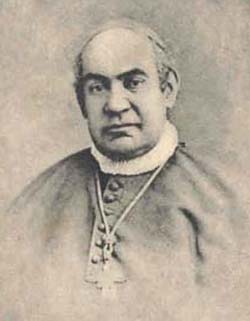
St. Anthony Mary Claret
|
He was a champion of papal infallibility and the fight against Freemasonry. A great devotee of Our Lady, he founded the Missionary Sons of the Immaculate Heart of Mary, known today as the Claretians. In 1869 and 1870, St. Anthony Mary Claret participated in the First Vatican Council. He died in the Cistercian monastery of Fontfroide in southern France on October 24, 1870.
Comments of Prof. Plinio:
A long time ago the Claretian Priests of the city of Rio Claro [in the State of Sao Paulo, Brazil] invited me to give a talk on their founder. I bought a small biography of him and read it on the trip. Many things can be said about this great Saint. He was one of these men who, aside from having founded a religious congregation, dominated his epoch by the mere fact of his existence.
He was a short, energetic Spaniard, a peppery Catalonian. At age 17 he traveled to the lively trade center of Barcelona to further himself in the weaving profession of his father. He became so involved in the technology and business that he could think of almost nothing else.
During this period of his life, he was a mediocre Catholic even though he maintained a devotion to Our Lady. One hot day in the summer of 1826, Anthony was wading in the sea when a huge wave engulfed him and carried him out into the deep. He could not swim, but called out to the Blessed Virgin for help, and found himself carried back to the shore, half drowned and semi-conscious. When he came to himself he realized how close he had come to dying. He began to consider the mediocrity of his life and he converted.
He was ordained a priest and became a missionary. He revealed himself an orator with eminent qualities who appealed to the simple people. He had a very powerful voice that could be heard in the far corners of the public squares where he used to preach to the multitudes that gathered to hear him. The churches could not contain all those people, and at times even the squares overflowed. He used to go from city to city preaching, and many times the inhabitants of one city followed him along the road to the halfway point, where he was met by inhabitants of the next city who had come to welcome him and accompany him to their city.
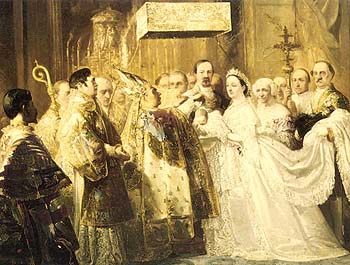
The Saint acquired great influence over the Queen and the Royal Family. Above, he baptizes one of its members
|
The preaching of St. Anthony Mary Claret attracted and held the people. His words were zealous, rich with learning and natural eloquence, and filled with extraordinary charismas. Very often he would move his audience to tears. At times he would prophesize, interrupting a sermon, for example, to tell a lady: “You think that you still have a long time to live, but you are mistaken. You will die in six months.” At other times he would exorcise demons, saying, for instance, “I will expel the Devil that hovers over this audience.” As he pronounced the words of the exorcism, strange noises, lightning, and other phenomena were heard and seen by the multitude. Of course, these charismas impressed and attracted the people.
He realized that he was called to preach the truths of the Faith to the simple people. Doing this, he gave an edifying example to other religious Orders that were influenced by Liberalism and rejecting the Church’s traditional preaching methods in order to adapt themselves to the modern world. St. Anthony Mary Claret achieved a fabulous result using the traditional methods. His implicit reply to those who attacked the traditional methods was simple: the people don’t come to you because of the old methods, but because you are liberals.
He also understood that he was called to increase the zeal of the people, not to organize or direct it. He would pass through the provinces planting the seed of the love of God, leaving the job of watering that seed and making it grow to others.
Only weeks after founding his missionary congregation of the Sons of the Immaculate Heart of Mary, notice arrived from Rome that he had been nominated to become Archbishop of Santiago, the primatial see of Cuba. He was consecrated Bishop, made an Archbishop, and sent to Cuba. As soon as he arrived, he started to correct the bad customs and indifferent morals of the people and began a real conversion of the Island.
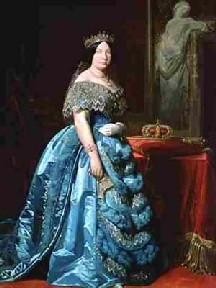
Through the maneuvers of Freemasonry, Queen Isabella II was deposed and exiled with her family and confessor
|
The Freemasonry that was deeply entrenched in Cuba could not tolerate this, and intensely attacked St. Anthony Mary Claret. He suffered all kinds of persecutions, including several attempts on his life. The opposition of the enemies of the Church was so strong that finally the Queen of Spain decided it would be more prudent to remove him from the Island and return him to Spain. At her request, he was offered the appointment of Patriarch of India, which would make him confessor and spiritual director of the Royal Court of Madrid.
As his ship left the shore of Cuba, St. Anthony Mary Claret cursed the Island whose inhabitants had refused God. It was not long before this curse took effect. With its independence, Cuba rejected the life-giving spiritual sap it had received from Spain, and quickly became a center of corruption and immorality, a tourist site for Americans seeking dissolute vacations. This was the case until Communism took over the Cuban government and implanted its regime. You can see that the curse launched by St. Anthony Mary Claret was realized quite impressively.
The chaplain of the Spanish Court had the title of Patriarch of India, but it was just an honorific title with nothing to do with India. Queen Isabella II was supporting the liberal side of the Spanish Royal House that was fighting against the good Carlist movement. As so often happens with liberals, they play the game of Freemasonry, and if they stop, Masonry takes them out of the game. Even though she was liberal, the Queen began to be influenced by St. Anthony Claret and gradually took a different position. When her policies started to become anti-liberal, the Masons removed her from power and sent her out of Spain in exile. It was St. Anthony Claret who provoked this political earthquake.
It was also during that time in Spain he exercised a very successful missionary apostolate and more firmly established the Congregation of the Sons of the Immaculate Heart of Mary.
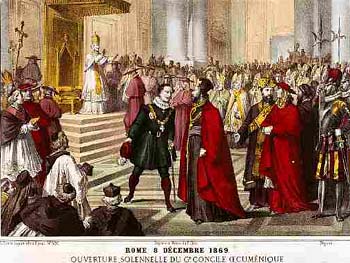
Pope Pius IX opening Vatican Council I
Scala, Art Resource, NY
|
The deposing of Isabella II was in part a victory for the good cause. The Masonry knew that Spain was not yet ready to accept a Republic, and wanted to establish a Constitutional Monarchy first in order to prepare the way for a stable Republic. Because it was forced to depose the Queen, it was obliged to make the Republic prematurely. This caused a deep crystallization in public opinion against the Republic, which led to the restoration of the Monarchy some time later. The Republic would have triumphed earlier in Spain without the action of St. Anthony Mary Claret.
Even as he grew old and suffered sicknesses, his incredible energy and gifts to move the people with his words continued. He was also granted many special graces, in particular, the grace of conserving the Sacramental Species within his heart. From one Communion to another, the Eucharistic Species were preserved incorrupt in his body so that he always had the Blessed Sacrament in his heart.
In his last days, he participated in Vatican Council I, which the Pope had convened at the Vatican in December of 1869. Seeing many liberal Bishops opposing the matter of Papal Infallibility that was being discussed, he became indignant and strongly censured them in a speech. Hearing the errors being spoken on this topic, he was so overcome with indignation that the blood rushed to his head and he suffered a stroke from which he never recovered. He died some months later.
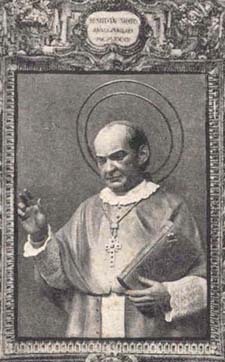
We should call on St. Anthony Mary Claret for his help under different titles
|
St. Anthony Mary Claret is our patron Saint under many different titles:
- the patron of those who are leading mediocre lives and need to convert to serve the Catholic cause;
- the patron of the faithful who promote devotion to Our Lady;
- the patron of counter-revolutionaries because of his action in Cuba and Spain;
- the patron of the those who follow the traditional methods of Catholic apostolate with the simple people and spurn the liberal novelties;
- the patron of those who fight for the Papacy against liberal Bishops.
Since it was this same current of Bishops that endured and took power in the Catholic Church at Vatican Council II, St. Anthony Mary Claret is also a great protector and intercessor of those who are called to fight the errors of Vatican II and its consequences.
We should call on St. Anthony Mary Claret for his help under these different titles.


  | | Prof. Plinio Corrêa de Oliveira | |
The Saint of the Day features highlights from the lives of saints based on comments made by the late Prof. Plinio Corrêa de Oliveira. Following the example of St. John Bosco who used to make similar talks for the boys of his College, each evening it was Prof. Plinio’s custom to make a short commentary on the lives of the next day’s saint in a meeting for youth in order to encourage them in the practice of virtue and love for the Catholic Church. TIA thought that its readers could profit from these valuable commentaries.
The texts of both the biographical data and the comments come from personal notes taken by Atila S. Guimarães from 1964 to 1995. Given the fact that the source is a personal notebook, it is possible that at times the biographic notes transcribed here will not rigorously follow the original text read by Prof. Plinio. The commentaries have also been adapted and translated for TIA’s site.
|
Saint of the Day | Home | Books | CDs | Search | Contact Us | Donate

© 2002- Tradition in Action, Inc. All Rights Reserved
|
 |

|